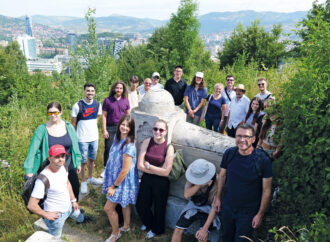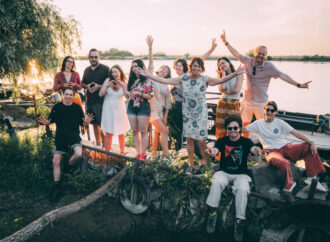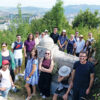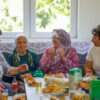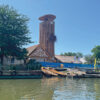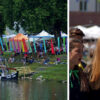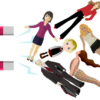It was just a generation ago that the Danube, Europe’s second longest river, was not a blue ribbon linking country after country like a string of pearls. By the way: more countries than any other river on this earth! 34 years ago, the Danube was part of the Iron Curtain that separated East and West.
It was just a generation ago that the Danube, Europe’s second longest river, was not a blue ribbon linking country after country like a string of pearls. By the way: more countries than any other river on this earth! 34 years ago, the Danube was part of the Iron Curtain that separated East and West.
You can hardly imagine this when you consider what an important connection this river was for people all those centuries before. For trade, for brave people who wanted to build a new life elsewhere, for the first river cruise tourists, for the exchange of culture and plain old everyday life: grain was ground with mills driven by Danube water, the now endangered sturgeon, the “King of the Danube”, was fished, as were many other fish. Important cities such as Budapest, Vienna and Belgrade were built.
And so, ignoring the border, the Danube just kept on flowing: from Donaueschingen via Ulm to the Black Sea.
20 years of the Danube Office Ulm/Neu-Ulm
20 years ago, the cities of Ulm and Neu-Ulm founded the Danube Office, as a kind of profession of faith. It was meant to reaffirm faith in Europe and European integration. It was supposed to counteract nationalist currents so that the history of division between the states along the river would not be repeated.
It did not remain a mere declaration of belief. The Danube Office filled it with life over the past two decades. For democracy and peace, it was felt, had to be lived from below. By the people who live in the Danube countries. In Ulm, the event format Donausalon (Danube Salon) was created, which since then regularly invites people to lectures, concerts and discussions. Numerous larger projects also developed.
The already legendary Danube Festival
A festival where every two years the motto is: a unique festival! Visitors are served a concentrate of all Danube countries: from Germany, Austria, Slovakia, Croatia, Hungary, Serbia, Romania, Bulgaria, the Republic of Moldova and Ukraine. There is typical wine from Austria and the Balkans, Ćevapi from Serbia, Croatian bean stew, colourful and flowery Ukrainian handicrafts, traditionally embroidered Romanian peasant blouses, and along the mile with stalls along the banks of the Danube in Ulm and Neu-Ulm, you can above all hear the Danube : music from the countries, people speaking the local languages and – at a late hour – happily lying in each other’s arms, belting out folk songs from the bottom of their hearts. Like past year at the Croatian stand. The festival attracted 405,000 visitors past year.
Commitment to Europe
The Danube Office (DBU) is also always involved in EU projects. Currently, the DBU and its project partners are promoting the European Energy Award and its dissemination in the Danube Region. The European Energy Award supports municipalities in implementing activities in the field of climate protection and sustainability. In addition, certifications can be obtained that promote public awareness.
The Danube Office is also committed to Ukraine. Since the beginning of the war, weekly vigils for Ukrainian refugees have been held on the market square in Ulm out of solidarity.
Discovering the Danube
How nice it is to discover the Danube countries – instead of always Italy or going off by plane to Spain or Thailand. This is what the tourism projects want to show. The focus is on gentle and sustainable tourism. Travelling by bike, on foot, by train or sometimes by boat. No fast food-like tourism, but conscious and intensive travel without destroying culture and nature. For this purpose, more than 90 “Danube Guides” were trained as tourist guides.
They are now just such nature-culture guides and convey the natural and cultural heritage of the Danube region. To adults, children, pupils, the local population and people with disabilities.
Past year, the EU project Transdanube Travel Stories was completed. Six travel routes through the Danube countries were created, each with a special focus: “Contrasting Europe”, “Nature Love”, “In the Footsteps of the Romans”, “Art and Culture”, “Danube Trade Route” and “Danube for the soul”.
On the website www.danube-pearls.eu, various influencers have presented the six travel routes, peppered with tips on sights, natural beauty, favourite places and the best way to get from A to B. The videos are also available in German. There is a short video as an appetiser, an overview of the cities and countries on the route and a downloadable itinerary. Photographer Dominic Lars Breitbarth tried out part of the “Nature Love” route with his girlfriend. He talks about the tour through the nature of Serbia, Croatia and Romania. He was particularly fascinated by the area around the Iron Gate because the Danube breaks imposingly through the mountains there. “A real gorge!”, he said. It was interesting that the water level at this point was only so high because the Danube was dammed.
Dominic Breitbarth would recommend Kopački rit in Croatia – a flooded area and a nature park on the Danube. “We went there with a ranger at sunrise. He showed us some places and where the water normally stands and drains away again.” There, the two also saw many animals: Cormorants, deer, pigs, eagles, black storks and kingfishers. As a photographer, Breitbarth was particularly fascinated by the beeeaters – an insanely colourful bird. “There are only a few places in Germany where you can see beeeaters.”
The “Danube Trade Route” trail looks at the Danube from the perspective of trade. The Danube is one of the oldest trade routes in Europe. In Ulm, the city tour “Ulm money rules the world” was developed. The guided tour can be boo- ked at the Ulm/Neu-Ulm Tourist Office or via the Future History app starting this summer.
By the way: The Ulm Danube Office is chirpy with its 20 years. It is already planning a series of exciting events for this year. For example, readings, concerts with panel discussions – for example together with the completely renovated Danube Swabian Central Museum and other Danube actors from Ulm and Neu-Ulm. But events in the beer garden Roxy are also on the programme.
Isabella Hafner, Ulm
INFO



